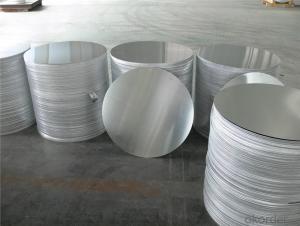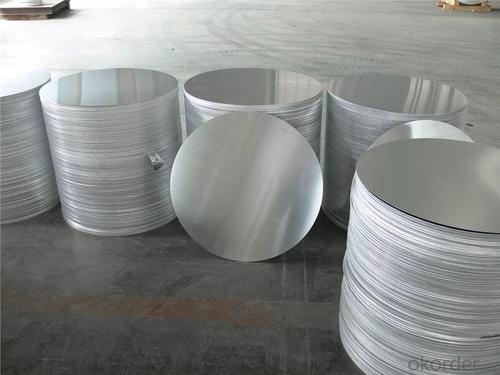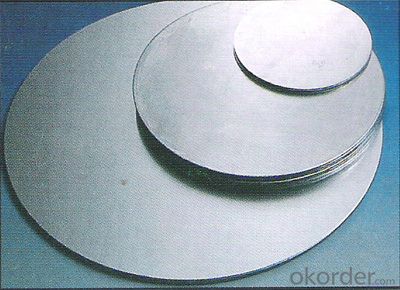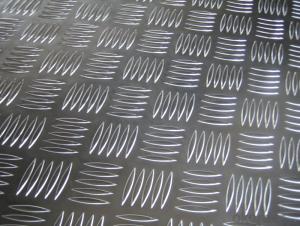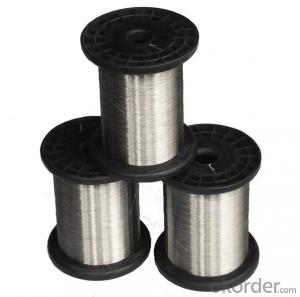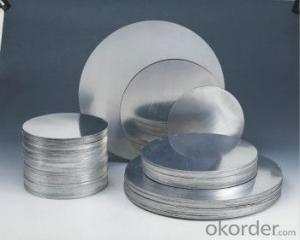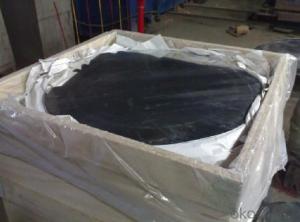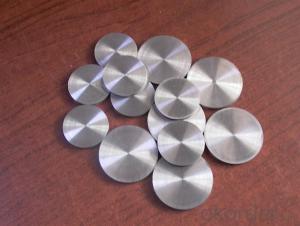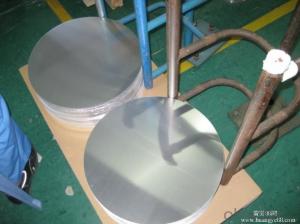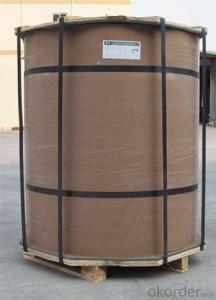Aluminum Sheets Iowa - Continuous Casting Aluminum Circle for Kitchen Cookware
- Loading Port:
- Shanghai
- Payment Terms:
- TT OR LC
- Min Order Qty:
- 2 m.t.
- Supply Capability:
- 50000 m.t./month
OKorder Service Pledge
OKorder Financial Service
You Might Also Like
Specification
1.Structure of Continuous Casting Aluminium Circle for Kitchen Cookware
Continuous Casting Aluminium Circle for Kitchen Cookware is one semi-finished aluminium material. This strip can be rolled down to aluminium coil,sheet,circle ect. The alloy AA1050 is widly used in building, industry ect. Its weight is much lower than steel. So many customers choosed aluminium material instead of steel.
2. Main features of Continuous Casting Aluminium Circle for Kitchen Cookware
a.Competitive price---We have our own mills and can produce mill finished aluminium coils, so we can control the production cost better.
b.Professional after-sale service---We have more than 15 years exportation experience and you need not worry about the exporation problems.
c.Fast delivery time---We can control the delivery time within 35 days.
3. Image
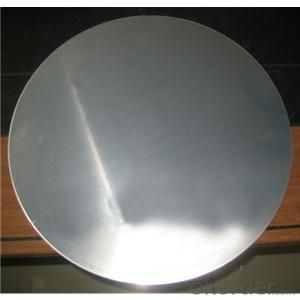
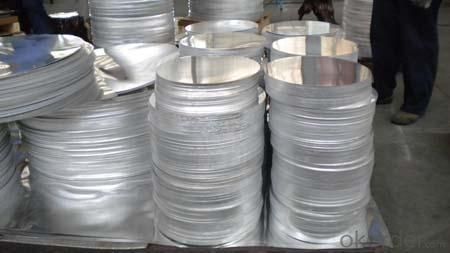
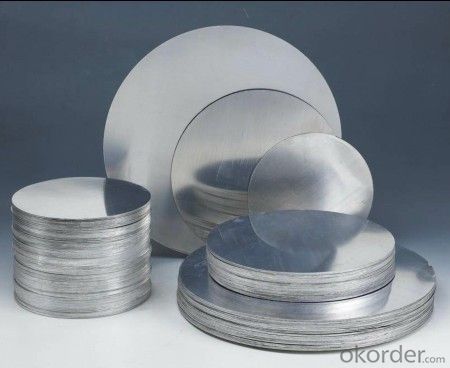
4. Product Specification
| Alloy | Temper | Thickness | Width | Weight |
| AA3003 | H14 | 0.2MM-3MM | 1000MM-1800MM | 2 TONS |
5.FAQ:
What is the quality standard?
---Usually our standard is GB3880-2006
What is the largest width?
---It is 2300mm
What is the MOQ?
---Usually we can accept 80 tons.
- Q: What is an aluminium plate? What is the difference between carbon steel sheet, galvanized sheet and stainless steel plate?What is the order of the price? Thank you
- It is aluminized sheet, which is mainly resistant to high temperature than galvanized sheet
- Q: What are the different types of edges available for aluminum sheets?
- Some of the different types of edges available for aluminum sheets include straight edges, beveled edges, hemmed edges, and rounded edges.
- Q: Are aluminum sheets resistant to rust?
- Yes, aluminum sheets are highly resistant to rust. This is because aluminum naturally forms a protective oxide layer on its surface when exposed to air, which prevents further corrosion. Unlike iron or steel, which can rust when exposed to moisture and oxygen, aluminum does not require any additional coatings or treatments to protect it from rusting. This makes aluminum sheets a popular choice for a wide range of applications, including construction, automotive, and marine industries, where resistance to rust is essential.
- Q: So I got this stainless steel ring but I took it to this place and apparently its not stainless it's aliminum bc of how light it is but it's really hard so how could it be aluminum?
- Aluminum is a quite soft metal, but so is gold. It is true that aluminum is light in weight but magnesium is even lighter and is common enough that a ring could be made of it. Metals can be made harder by adding small amounts of other metals or even by the way it is heat treated. .
- Q: What does 3003-O aluminum mean?
- 3003 is a kind of AL-SI alloy of Al Mn alloyThere are four basic states of aluminum alloys:F--Free the condition of a product after a normal working procedure requires no special heat treatment or hardening, and the mechanical properties are not limited.H-- strain hardening statusO-- annealed state (the softest of all States)T-- heat treatment status
- Q: What are the potential safety issues that may arise from the use of aluminum sheets?
- <p>Aluminum sheets are generally safe to use in most applications. However, there are a few safety concerns to consider. First, aluminum can be a skin irritant for some individuals, so it's important to wear protective gloves when handling. Second, aluminum dust, when inhaled, can cause respiratory issues. Proper ventilation should be maintained during cutting or grinding operations. Lastly, aluminum can conduct electricity, so it should not be used in electrical applications without proper insulation. Always follow safety guidelines and use protective equipment when working with aluminum sheets to minimize these risks.</p>
- Q: How to clean the engine oil and kerosene on the surface of aluminum sheet?
- You can clean it with detergent of carburetor, and buy it in auto accessories shop.
- Q: What are the advantages of using aluminum sheets over other materials?
- There are several advantages of using aluminum sheets over other materials. Firstly, aluminum is a lightweight material, making it easier to handle and transport compared to heavier materials such as steel. This makes it more convenient for various applications, especially in industries where weight reduction is important. Secondly, aluminum has a high strength-to-weight ratio. Despite its lightweight nature, aluminum sheets are incredibly strong and have the ability to withstand heavy loads and impacts. This makes it an ideal choice for construction, aerospace, and automotive industries, where durability and structural integrity are crucial. Additionally, aluminum is highly corrosion-resistant. It forms a protective oxide layer that prevents rust and corrosion, even in harsh environments. This makes it suitable for outdoor applications, such as building facades, roofing, and marine structures, where exposure to moisture and other corrosive elements is a concern. Moreover, aluminum is a highly malleable material, allowing it to be easily formed into various shapes and sizes. It can be rolled into thin sheets or extruded into complex profiles, offering design flexibility for different applications. This makes aluminum sheets versatile and adaptable in a wide range of industries, including manufacturing, architecture, and transportation. Furthermore, aluminum is a sustainable and recyclable material. It has a relatively low melting point, requiring less energy to recycle compared to other materials. This makes aluminum sheets a more sustainable choice, promoting environmental conservation and reducing the carbon footprint. In conclusion, the advantages of using aluminum sheets over other materials include its lightweight nature, high strength-to-weight ratio, corrosion resistance, malleability, and sustainability. These properties make aluminum sheets an excellent choice for a variety of applications, where performance, durability, and environmental considerations are essential.
- Q: Are aluminum sheets suitable for heat exchangers?
- Yes, aluminum sheets are suitable for heat exchangers. Aluminum is a highly conductive metal, which allows for efficient heat transfer. Its lightweight nature makes it easy to handle and install in heat exchanger systems. Additionally, aluminum is highly resistant to corrosion, ensuring the longevity and durability of the heat exchanger. Furthermore, aluminum sheets can be easily formed into different shapes and sizes, making them customizable for various heat exchanger designs. Overall, aluminum sheets offer excellent thermal conductivity, corrosion resistance, and versatility, making them a suitable choice for heat exchanger applications.
- Q: What are the different methods for cutting aluminum sheets?
- Aluminum sheets can be cut using various methods that are commonly employed. 1. Shearing: To make a straight cut through the aluminum sheet, a sharp blade is used in this method. Shearing is typically used for thinner sheets and results in clean and straight cuts. 2. Sawing: Another method for cutting aluminum sheets is sawing. It involves the use of a saw blade with small teeth to cut through the material. Sawing can be done manually or with the assistance of power tools like band saws or circular saws. 3. CNC Machining: For highly precise cutting of aluminum sheets, Computer Numerical Control (CNC) machining is employed. This method utilizes a computer-controlled machine that follows programmed instructions to achieve the desired shape. CNC machines are capable of creating complex cuts and shapes with great accuracy. 4. Laser Cutting: A non-contact method, laser cutting, employs a high-powered laser to cut through aluminum sheets. The laser beam melts or vaporizes the aluminum, resulting in a clean and precise cut. Laser cutting is commonly used for intricate designs and offers a high level of precision. 5. Waterjet Cutting: Waterjet cutting involves the use of a high-pressure jet of water mixed with an abrasive substance to cut through aluminum sheets. This method is versatile and can be used for various materials and thicknesses. It produces clean cuts without generating heat, making it suitable for heat-sensitive materials as well. 6. Plasma Cutting: Plasma cutting utilizes a high-temperature plasma arc to cut through aluminum sheets. The plasma arc melts the metal and blows away the molten material, creating the desired cut. This method is commonly used for thicker aluminum sheets and can be done manually or with the assistance of CNC machines. These different cutting methods offer varied precision levels, speeds, and suitability for different sheet thicknesses and designs. The choice of cutting method depends on factors such as the desired cut quality, aluminum sheet thickness, and specific project requirements.
Send your message to us
Aluminum Sheets Iowa - Continuous Casting Aluminum Circle for Kitchen Cookware
- Loading Port:
- Shanghai
- Payment Terms:
- TT OR LC
- Min Order Qty:
- 2 m.t.
- Supply Capability:
- 50000 m.t./month
OKorder Service Pledge
OKorder Financial Service
Similar products
Hot products
Hot Searches
Related keywords
